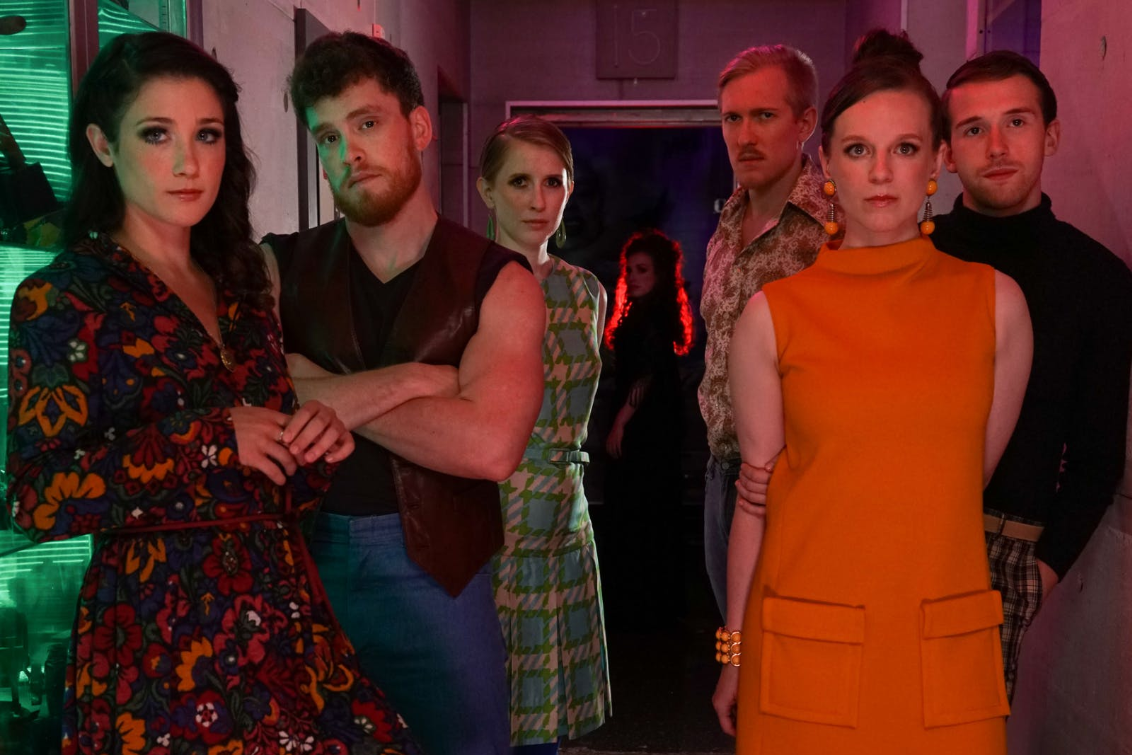Who Killed Edgar Allan Poe? The Cooping Theory 1969
Conceived and Directed by Aaron Salazar
Produced by Poseidon Theatre Company
Off Broadway, Immersive Experience
Runs through 11.2.19
RPM Underground, 244 West 54th Street
by Asya Gorovits on 10.3.19
 The cast of Who Killed Edgar Allan Poe? Photo by Michael Gallo.
The cast of Who Killed Edgar Allan Poe? Photo by Michael Gallo.
BOTTOM LINE: An immersive psychological thriller kills with its stellar visual and audio design, but lacks narrative coherence.
I sit at the table in a funky karaoke bar, when Crispin (Brian Alford) asks me if I have any books at home that I haven’t read yet. I nod. “What makes you think that when you open one of those books, you won’t just see blank pages”? Okay… He then says something about some people being similar to those blank books: there is nothing behind their eyes, no inner life. Crispin stares at me intensely, his face inches away from mine, and I can’t tell if he is messing with me or truly believes his own words. After all, this is a gathering of he Poe Society and we are here to summon the writer's spirit.
Who Killed Edgar Allan Poe? is a remount of Poseidon Theatre Company’s 2017 production, and casts the audience as new members of the Poe Society. This time around, the action takes place in 1969, not 1949, and the format is an immersive sandbox, meaning that audience members are not confined to their seats or specific tracks and are free to explore and follow any character.
For the first hour of the show, we are encouraged to have drinks and food and mingle with the established society members: paranormal activity scholar Gina (Samantha Lacey Johnson), free-spirited musician Jimmy (Johnny Pozzi), eccentric Anna (Makaela Shealy) and Tom (Aaron Latta-Morissette), the owner of the joint. Siblings Crispin (Brian Alford) and Cordelia (Estelle Olivia) are attending for the first time but seem to fit right in with their calm and slightly creepy demeanor.
All of these characters have their own experience with the paranormal, which they gladly share with anybody who asks. I venture into the discussion about fate with Cordelia and sing along to "The House of the Rising Sun" with Gina and Jimmy. For a moment I even forget that I am in a theatre. The happening seems exactly what it portrays: a 60’s-themed cocktail party in an artsy underground club (venue design is by Seok Huh), which, by itself, is pretty cool. The period design—costumes by Samantha L. Johnson and hair and makeup by Jeremy Gatzert—is spot on. Some audience members even dress up as a nod towards the era, which creates delightful confusion around who exactly are actors and who participants.
The ring of a bell interrupts conversations mid-sentence. As explained during the onboarding, we have to refrain from speaking once the seance starts. Highly theatrical motions of purifying the room and the show-stopping appearance of Madame Harlow (Dara Kramer) are perfectly suitable for the occasion. Anticipation builds and then…the seance goes out of control as spirits possess the members of the Society one by one. Heavy metal doors are slammed and tiny karaoke rooms become chambers of fear, hope, despair, and pathos. The original score (by Manuel Pelayo and Giancarlo Bonfantia), coupled with the sound design (by Sung Oh), makes the hair on my neck stand up. The spectacular lighting evokes the gory, mind-twisting atmosphere of Dario Argento’s giallo films with restlessly vibrant, contrasting colors.
Since its premiere two years ago, Who Killed Edgar Allan Poe? has significantly advanced in some aspects, but failed to achieve more clarity in others. Changing the format from a dinner party to an immersive experience serves the show well; bringing the action to 1969 allows for some alluring visual design, and the designers thrive on it. However, the structure and the plot still remain somewhat underdeveloped. There are some vague hints as to the personal circumstances of each character that comes through, but the parallels could be clearer.
After spending an hour mingling with our hosts, I got attached to some of them and would love if the poetry would allow me to look more deeply into their souls. The mysterious circumstances of Poe’s death and "the cooping theory" are briefly addressed in the beginning of the show, but are soon dropped from the picture. Who Killed Edgar Allan Poe? might not give you a clear response to the titular question, but if you are up for an atmosphere of new perspectives on theatre, this show is for you.
(Who Killed Edgar Allan Poe? The Cooping Theory 1969 plays at RPM Underground, 244 West 54th Street, through November 2, 2019. The running time is 2 hours with no intermission. Performances are Mondays at 7, Wednesdays at 3 and 7, and Saturdays at 3 and 7. Halloween week performances will be Monday at 7, Tuesday at 7, Wednesday at 3 and 7, Thursday (Halloween) at 8, Friday at 7, and Saturday at 3 and 7. On Halloween, all ticket holders will be invited to a costume party contest hosted by the Poe Society. Tickets are $75 and are available at knock3xs.com. There is a $25 beverage/food minimum per guest.)
Who Killed Edgar Allan Poe? The Cooping Theory 1969 is conceived and directed by Aaron Salazar. Co-direction and Book by Nate Raven. Additional Material by Edgar Allan Poe. Original Score by Manuel Pelayo and Giancarlo Bonfanti. Sound Design by Sung Oh. Venue Design by Seok Huh. Costumes by Samantha L. Johnson. Hair and Makeup Design by Jeremy Gatzert. Associate Producer is Rachel Shaw. Stage Manager is Allie Marotta.
The cast is Brian Alford, Samantha Lacey Johnson, Dara Kramer, Aaron Latta-Morissette, Estelle Olivia, Johnny Pozzi, and Makaela Shealy.

